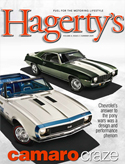Camaro: Life in the Fast Lane
Like its Mustang rival, the Camaro is no stranger to a racetrack. Especially the drag strip, where Chevy’s pony car has long been a popular weapon of choice for grassroots ground-pounders, due to various factors: It’s always been plentiful, relatively cheap (to both own and build) and possessed mucho performance potential.
On the professional side, Camaros were especially competitive in 1969 in Super Stock drag racing, thanks to the creation of the awesome ZL-1 rendition with its all-aluminum 427 big block V-8. They remained popular in the less restrictive Pro Stock class, which superseded old-school S/S racing during the 1970s. Camaro also was the official car (and the first American model) used in the International Race of Champions series from 1975 to 1989. But hands down the greatest glory came on the Sports Car Club of America’s (SCCA) Trans-Am circuit, which opened for business in 1966.
Ford’s Mustang led the way during the SCCA’s inaugural Trans-American Sedan Championship season and made it back-to-back championships in 1967. Then along came the Z/28, created entirely with Trans-Am racing in mind. Chevy had entered the Trans-Am fray in February 1967 at Daytona, where a 302-powered Camaro finished second to a Dodge Dart. Mark Donahue, driving for Roger Penske, managed three wins that year at the wheel of a Z/28, including the season’s last two races. Ford may have won the war in 1967, but Chevrolet was clearly gaining battle experience.
Penske Racing’s beautiful blue Sunoco Camaros won 10 of 13 Trans-Am races in 1968, with Donahue himself taking eight straight checkered flags. A Shelby Racing Mustang was the Daytona winner, but Ford’s pony car stumbled badly from there, allowing Chevrolet to clinch its first SCCA title upon completion of the season’s ninth event.
Ford retaliated with its Boss 302 Mustang. Facing off this time against Penske’s formidable Sunoco cars were two Ford teams, the existing Shelby Racing group and a second shepherded by Bud Moore. Driven by Parnelli Jones and George Follmer, the two Bud Moore Engineering Boss Mustangs made the most hay in 1969, and by year’s end, it was relatively clear that Shelby’s time in Trans-Am competition was coming to a close. Too bad the same couldn’t be said for Penske Racing’s dominance. The Boss Mustang closed the gap, but it couldn’t quite catch Chevy’s Z/28, which won eight of 12 Trans-Am races in 1969.
As predicted, Bud Moore Engineering’s two Mustangs returned for the 1970 Trans-Am season, but Shelby Racing’s cars didn’t, due to Henry Ford II’s decision to slash spending at the track. Meanwhile, Roger Penske jumped from GM to American Motors, leaving Jim Hall to run Chevrolet’s Trans-Am program. Moore’s Mustangs battled Penske’s Javelins closely – not Hall’s Camaros – before finally clinching the 1970 Trans-Am championship at Kent, Washington, in September.
By April 1971, Detroit’s Big Three players had withdrawn from Trans-Am competition, leaving the heady days of 1970 and 1971 as a climax many road racing fans still haven’t forgotten.
***
To see this article in its original format, view the pdf version of the Summer 2009 issue of Hagerty magazine.


